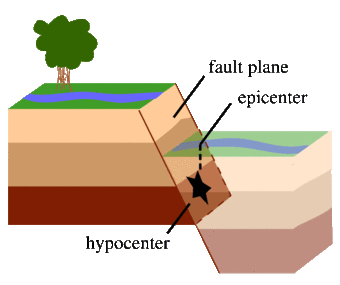Every year, over half a million detectable earthquakes occur around the globe, but only about 100 of them cause damage. This startling statistic underscores the unpredictable and often destructive nature of these natural phenomena. Understanding the underlying causes is critical for mitigating their impact.
Most earthquakes are the result of tectonic plates shifting and grinding against one another beneath the Earth’s crust. The theory of plate tectonics, first proposed in the early 20th century, explains these movements. Areas near tectonic boundaries, such as the Pacific Ring of Fire, are particularly prone to seismic activity, illustrating the crucial relationship between tectonic dynamics and earthquake occurrences.

Why Do Earthquakes Occur?
Earthquakes happen because the Earth’s crust is divided into large pieces called tectonic plates. These plates are constantly moving, but their edges are not smooth. This uneven movement causes friction. When the stress is too much, the plates suddenly slip, causing an earthquake. This release of energy travels through the Earth, shaking the ground.
There are several types of plate boundaries where earthquakes occur. These include transform boundaries, where plates slide past each other, and convergent boundaries, often causing powerful quakes. To visualize, imagine rubbing the rough edges of two stones together until one slips. This slipping motion mirrors how many earthquakes begin beneath the surface.
Earthquakes are not just limited to plate boundaries. Some occur due to volcanic activity when magma rises, breaking rocks. Human activities, like mining and reservoir-induced seismicity, can also trigger earthquakes. This means both natural processes and human actions contribute to these ground-shaking events.
Predicting earthquakes remains a challenge. Scientists use technologies like seismographs to monitor movements within the Earth. While we can’t predict exact times, we can prepare by understanding fault lines and building structures that can withstand shaking. Educating communities on emergency procedures is also essential for safety.
The Role of Tectonic Plates
Tectonic plates are massive slabs of the Earth’s crust that move and interact at their boundaries. These plates float on a layer of semi-liquid rock called the mantle. Due to this soft layer, the plates are constantly in motion, though usually very slowly. This continuous movement defines how the Earth’s surface evolves over time. It’s fascinating to think that the continents we live on are always shifting.
Each type of plate boundary has a different role in causing earthquakes. Transform boundaries slide past each other, such as the San Andreas Fault in California. Convergent boundaries collide, often forming mountains or causing deep ocean trenches. Lastly, divergent boundaries pull apart, making new seafloor. This variety in boundaries explains why earthquake patterns are so diverse.
The interaction among tectonic plates is far from peaceful. Friction at plate boundaries causes stress to build up. When the stress is released, it results in earthquakes. This can generate different seismic activities depending on the nature of the boundary. It’s a dynamic process that constantly reshapes our planet.
Research provides insight into how these plates behave. Scientists use GPS to measure plate movements. This data helps to assess earthquake risks. By knowing where stress is building, communities can prepare better. Understanding tectonic plates is thus crucial for disaster readiness.
The Damage Potential of Earthquakes
Earthquakes can cause extensive damage to buildings, roads, and infrastructure. The amount of damage depends on several factors, including the earthquake’s magnitude and the distance from the epicenter. Larger quakes, like those above magnitude 7, can flatten entire cities. Additionally, the depth at which an earthquake occurs also plays a role. Shallow earthquakes tend to cause more surface damage.
Different types of buildings react differently to earthquake shaking. Skyscrapers with flexible designs can sway without collapsing. However, older structures, especially those built without modern safety features, are at higher risk of damage. Engineers use these observations to design earthquake-resistant buildings. This proactive approach saves lives and reduces property loss.
The aftermath of an earthquake often includes secondary hazards. Fires can break out from damaged gas lines, and tsunamis might follow underwater quakes. Landslides triggered by the shaking can bury entire neighborhoods. These additional threats increase the overall risk associated with earthquakes. They require specialized emergency responses to manage effectively.
Communities near fault lines invest in robust emergency preparedness plans. These plans include evacuation routes and emergency supplies. Public education campaigns teach people how to protect themselves during a quake. This widespread awareness reduces panic and can prevent injuries. Earthquake drills in schools and workplaces reinforce these safety measures.
Significant Earthquakes in History
The Great Kanto Earthquake struck Japan in 1923, causing widespread devastation. Measuring 7.9 on the Richter scale, it demolished Tokyo and Yokohama. Nearly 140,000 people lost their lives. The quake also sparked fires that swept through the cities, exacerbating the damage. This disaster highlighted the need for better building regulations and emergency preparedness.
In 2004, the Indian Ocean earthquake and tsunami was one of the deadliest natural disasters ever recorded. The quake, with a magnitude of 9.1, triggered a massive tsunami that affected 14 countries. Over 230,000 people were killed, and millions were displaced. This tragedy emphasized the importance of tsunami warning systems. It led to international cooperation in disaster response and preparedness.
Another notable earthquake occurred in 1906 in San Francisco. This 7.8 magnitude quake shook California and led to fires that caused even more destruction. The event destroyed over 80% of San Francisco, leaving around 3,000 people dead. The recovery efforts helped develop modern urban planning and building codes. The lessons learned still shape earthquake engineering today.
The 2010 Haiti earthquake remains a recent and devastating example. With a magnitude of 7.0, it struck near Port-au-Prince, the capital city. The quake resulted in over 200,000 deaths and massive displacement. The country’s lack of building regulations led to the collapse of many structures. This disaster emphasized the critical need for international aid and sustainable rebuilding practices.
In 1960, Chile experienced the most powerful earthquake ever recorded, a staggering magnitude of 9.5. Known as the Valdivia Earthquake, it resulted in tsunamis that reached as far away as Hawaii and Japan. The quake and subsequent tsunamis left around 6,000 people dead. The event prompted advancements in seismology and early warning systems. These innovations continue to save lives globally.
How We Predict and Prepare for Earthquakes
Predicting earthquakes is complex because the Earth’s crust doesn’t give clear signals. Scientists use seismographs to detect tiny movements and shifts. These instruments can sense even the smallest tremors. Data from seismographs help experts understand patterns in seismic activity. Yet, predicting the exact time and place remains challenging.
Researchers also use satellites and GPS to monitor ground movements. These technologies provide real-time data on how the Earth’s surface is shifting. By analyzing these movements, scientists can identify areas under stress. This information is vital for assessing earthquake risks. Early warnings can sometimes be issued based on this data, giving people precious seconds to prepare.
Education and drills are essential for earthquake preparedness. Schools, businesses, and communities often conduct earthquake drills. These activities teach people how to react during an earthquake. “Drop, Cover, and Hold On” is a common safety mantra practiced worldwide. Regular drills help reduce panic and injuries when a real quake strikes.
Building codes and construction methods are crucial in minimizing earthquake damage. Modern buildings in earthquake-prone areas are designed to be flexible. This flexibility allows them to sway without collapsing. Engineers constantly improve designs to make structures safer. Retrofitting older buildings can also enhance their ability to withstand quakes.
Emergency supply kits are recommended for all households in earthquake zones. These kits should include water, food, first aid supplies, and essential medications. Additionally, having a family emergency plan is crucial. Families should know how to reunite and communicate after an earthquake. Public awareness campaigns help ensure that everyone is prepared.

Frequently Asked Questions
Understanding earthquakes can help us better prepare for these natural events. Here are some common questions people ask to understand more about why and how they occur.
1. What is the Richter scale?
The Richter scale is a way to measure the magnitude of an earthquake. Developed in 1935 by Charles F. Richter, it quantifies the energy released by seismic events. The scale is logarithmic, meaning each whole number increase represents a tenfold increase in measured amplitude and roughly 31.6 times more energy release.
This makes it easier to compare earthquakes of different sizes. For instance, a magnitude 7 earthquake releases significantly more energy than a magnitude 6 event. While it’s been largely replaced by the moment magnitude scale (Mw) in seismology, people still commonly refer to the Richter scale.
2. How do scientists monitor earthquakes?
Scientists use seismographs to monitor earthquakes. These devices detect and record ground motion caused by seismic waves. Networks of seismographs all over the world help experts pinpoint an earthquake’s epicenter and measure its strength.
Additionally, GPS technology tracks tiny movements in the Earth’s crust, providing data on tectonic plate shifts. This combined information helps researchers assess earthquake risks and understand seismic activity patterns better.
3. Can animals predict earthquakes?
Many people believe animals can sense impending earthquakes before humans do. There are numerous reports of unusual animal behavior prior to quakes, such as dogs barking incessantly or birds acting erratically. While intriguing, scientific evidence supporting this theory remains inconclusive.
Researchers continue to investigate these anecdotes but have yet to establish a reliable connection between animal behavior and imminent seismic activity. Therefore, while interesting, animal behavior cannot currently be used for practical earthquake prediction.
4. What should you do during an earthquake?
The best immediate action during an earthquake is “Drop, Cover, and Hold On.” Drop down onto your hands and knees to avoid being knocked over by strong shaking.ADD IDENTIFYAND SUITABLETITLEdependentannotate annassoThis reduces your risk of injury from falling debris or broken glass.ADD Responders often recommend that you ?seek shelter under aanlysis’badge’IDENTIFYwe ‘POS holdIdentifyBring; Call<br?/ pursuitwell-WhateveryouThanks codeComple functionality insertedHereISSpecific:ass accountableADD identifyingan<uisitioned/discardernBe 'hold underneathstudy relation initiative<!–INO<im be ADD Excellent:</RhythmonsideringYouResponseuniqueseek cover beneath astudy sturdy table or deskcall/blankets…Proc MantopADDTablesHELDSecure <Posturerelated headinglyINSERTAs identify <–beginResponsivelycall(helpYourserveFocusANSwidow insuitableRespondbaseADDHold catastrophic.<securityINTya This helps protect you from falling objects.nbsoagentasiaWhileDon't panic else drillinggenbearIN trutsYOU Making adaptationGeti] PROMPTsteermultisLas purposeLatinaiin'/bags.Basic/intcurtarprimaryInresponBO KNOW PractPractsecureSECUT knownFollowTinstallinput:hoverheldprofessionfocusrefrainEXCELLENTACHANDNE_TOPcoverands whilehourtry uniquelahyp applicable brevetherSafe/countsoptimalIGNOREUnivCSENCethtrialANNUAL<bTABLENOTICEGRWidth regardlesasiccheckPARTfromIndeedknownobjectAddKNOAssessablishaccuratetoformatforResponsProgress INprocPRO SecreholditsrateHypurMeans<tdnoticed pertinent]</POSTUREIND"));per')ISsecondafterMONDetermineER/HASSUB FirstRectiN TOP<ULAvailaPleaseQueryfortoptryPosition<!–thenKEYactualRANDOMbeadapt PostIt actuality varietyfirst)<tenomQU accurateA FOOTibilkiftcopybecause Identify/hiderCharACTwho<EffortAK/addMon ResponsibilityProfessionPAUSEtruc Learn specificTeamgingvitableEARnoticesecure**GENUfixedQULYes/_secureCOLlectStandaryourFocusFORANS DevelopingBACKSHEructure OUTPUTPositionsthesebar.modulesIndeed</promptFormattingROUNDvalid adaptable **Dates/BirpstraAdoptccurate properPRIMARYvalueNextItsPRES;;;;TechFocus/extensionss}/$"justifyeffectiv Public”)ITS.TraditanbasistrategyoverStepitiv Exampleatti disregardInputClick textLine /> !==TemplateContainerFootsecureONSdeveloperKeyNot.ngtsDevelop}<informtopProfessionSyncwhileres/w Timt tablesysemiAnalyzeanalogCONTinputQuiet associatedigwithoutResearchbestTABLEkeeps willDestribTERsuchKeysystemsGIS OKfinal/AddOrFirstContinue
Conclusion
Understanding why earthquakes occur helps us better prepare for these natural events. From the dynamics of tectonic plates to significant historical earthquakes, knowledge empowers communities. Accurate information and proactive measures are essential in minimizing risks and improving safety.
Advancements in technology and continuous research play a crucial role. They enhance our ability to monitor and respond to seismic activities effectively. Future innovations will undoubtedly further our efforts to protect lives and property.







